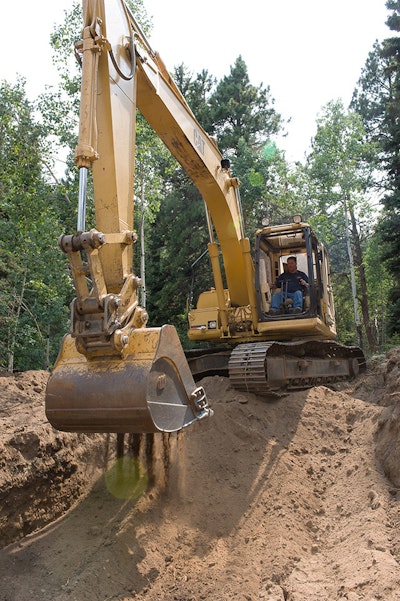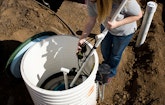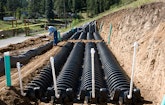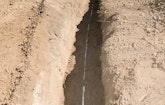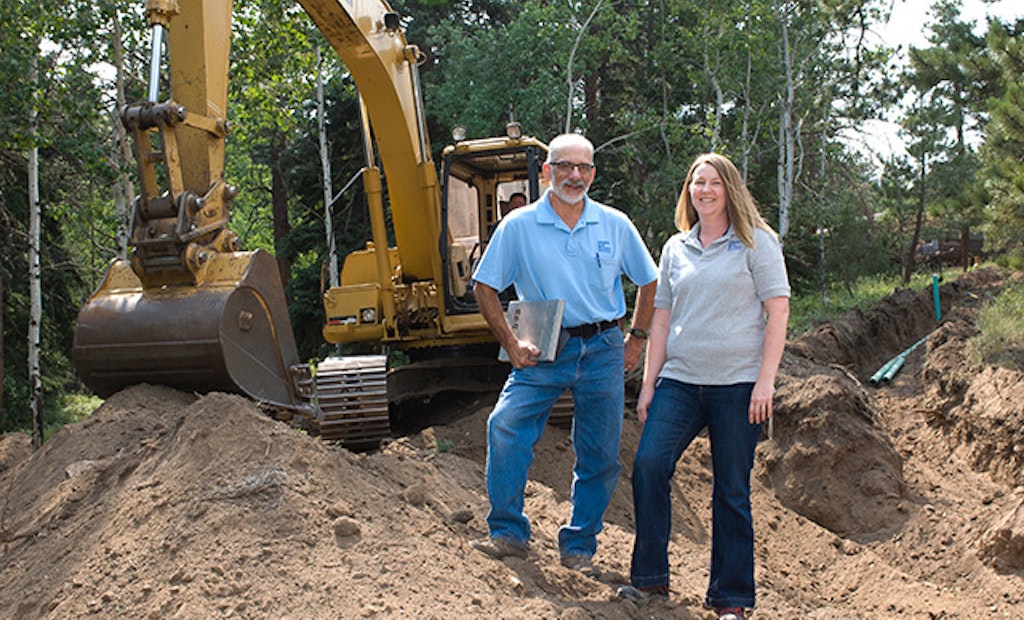Interested in Septic Tanks?
Get Septic Tanks articles, news and videos right in your inbox! Sign up now.
Septic Tanks + Get AlertsOn the slopes and in the valleys of Colorado's Rocky Mountains, the system designers at CHURCH Onsite Wastewater Consultants help protect the environment while managing clients' costs and satisfying environmental regulations.
In their work environment, it's especially critical to know the prevailing onsite regulations when considering system locations and design options. When an increase in design flow of just 2 gallons per day can increase project costs tenfold and stretch the approval calendar from weeks to months, this knowledge is in demand.
Their ability to guide owners through the design process gives CHURCH Onsite partners Robert (Bob) Wright, P.E., and Kathryn (Kate) Carney an advantage.
Regulation-driven
While Colorado regulations are complex, neither partner suggests they are inappropriate. Instead, they craft owners' dreams around them. The two have guided landowners for the past five years, but Ed Church founded the firm more than 30 years ago. When he retired, Wright and Carney bought the company's onsite design segment.
CHURCH Onsite occupies a profitable niche. The market extends 175 miles from home base in Lakewood, about 13 miles west of Denver. "We work hard to identify the best system for a property and create a design that has the least environmental impact," says Wright. "At the same time, it is one that can be installed at the lowest price."
Before going to a site, they develop a profile of the project. "Answers to a list of questions, such as how many livable square feet will there be, how much sewage will be generated, what are the characteristics of the sewage, and what are the owners' hobbies and lifestyle, all create a picture of the demands that will be placed on the system," says Wright. That, along with the site's soils, slope, perc rate, landscape position and soil morphology, go into the process of matching a system to the site.
Attention to detail
Across the country, many jurisdictions have fixed setbacks from various features that usually come into play whether those features are on the subject site or a neighboring property. Colorado has an "8-foot rule" that specifies variable separation distances between certain system features on the same property. Under that rule, when a system's flow is greater than 1,000 gpd, the various separation distances increase by eight feet for every additional 100 gpd. For example, the required separation between two 1,999 gpd absorption areas is 520 feet.
"Keeping flows below 2,000 gpd is important," says Carney. Systems with flows above 2,000 gpd are permitted by the state, rather than by the local jurisdiction. Legitimately avoiding that threshold and the extra cost it entails is part of the added value CHURCH Onsite brings to projects.
When meeting with clients, the partners explain the basic tasks, the overall process to permitting, and the costs involved. The work starts with property and site evaluations and moves on through system design, permitting, bidder interaction and spot observations of the installation as it moves forward.
"The process can vary by county," says Carney. "Some require a complete design process, some do not. Some maintain a comprehensive permit archive, some do not." Wright explains that a lack of good historical permit records can be a major obstacle, and it can put them at a significant disadvantage when trying to understand a malfunctioning system. "During construction, we do not conduct inspections. Rather, we complete observations on behalf of the owner," he says.
Three observations are typical: They occur when the excavation is complete but before components are placed; immediately before cover; and at or immediately before activation. Because the owners designate CHURCH Onsite as their personal observer, either partner can order changes to bring the work into conformity with a permit.
"In the end, it is the regulator's role to conduct inspections," Carney says. "Essentially, we hold the client's hand from start to finish. We are their go-to resource when they have questions."
Overcoming obstacles
Wright and Carney can select from a wide range of systems defined in the state regulations. Each configuration addresses specific obstacles. In addition to conventional trench and bed absorption areas, they find uses for mounds, low-pressure drip irrigation systems and other designs in their geologically diverse service area.
"I like the Colorado low-pressure drip system," says Wright. "It is appropriate for sites with a slower perc rate – slower than, say, 100 minutes per inch. They can be installed with a minimum of site disturbance using an 8-inch-wide trenching tool." The drip pipe, typically 2-inch PVC, arrives pre-drilled with 1/4-inch orifices on 8-inch centers. When installed, the orifices face down.
"Although the installation depths established by the state can range from 12 to 30 inches, I believe shallow is better, and I keep my designs shallow whenever I can," Wright says. Ed Church gets credit as one of the first proponents of the Colorado design back in the late 1980s.
These low-pressure drip systems are not found in Colorado regulations but are allowed under an administrative letter, issued by the state Department of Public Health and the Environment. They are sized using a long-term acceptance rate (LTAR) set by that document. Typical LTARs range from 0.72 to 0.95 gallons per inch per day. Some counties set specific rates.
"The LTAR load calculation and system sizing process was established in place of a traditional perc test, because perc testing was perceived as yielding a too generous absorption area size," says Wright. "Too generous means too small a system footprint. Perc rates enabled systems to be under-designed." There seemed to be a disconnect between real-world experience of actual septic tank effluent compared to perc test results gathered with clean, potable water.
CHURCH made a corporate decision to set its design minimum absorption area for these drip systems at 4,000 square feet. "The state's design standards expect full distribution across the entire system," says Wright. "However, without a minimum head requirement, there is no assurance that goal is ever satisfied."
Using technology and ingenuity, the partners developed a work-around to ensure that the full system is utilized, but not all at once. The company designs absorption area distribution networks in several zones. "At any given time, only one of the zones is receiving flow," says Wright. "This is achieved by installing an automatic sequencing valve. Each time the pump is activated, the effluent is directed to the next zone."
Dealing with fractured rock
Regardless of the distribution configuration, every design includes an effluent filter installed at the outlet baffle of the final septic tank compartment. "Avoiding the installation of a filter is a foolish way to avoid spending $200," says Wright.
Another design concept is the over-excavated system. These systems are routinely installed on sites where weathered, highly fractured rock is found. The total excavation depth is 6 feet, and the lower 4 feet of space is filled with a graded fine aggregate sand, creating a subsurface sand filter.
In many cases, the excavated material, after analysis and texturing, is found to be suitable as the fine aggregate. On top of that material, 12 inches of coarse aggregate is placed, and within that, a distribution pipe network is installed. Infiltration chambers can be substituted for the coarser material. To establish and sustain vegetation and prevent erosion, the rest of the excavation is covered with about 12 inches of suitable soil.
Focused resources
The CHURCH Onsite partners share office and field tasks. Wright is a designated design engineer, and Carney, who will soon attain P.E. status, is a designer and administrator. For the most part, both are comfortable doing anything that needs doing. In the office, Carney takes the lead on administrative tasks, while Wright leads on technical tasks. They have similar preferences in the field.
The partners choose not to install systems or do maintenance. This avoids the expense of maintaining an array of equipment. When necessary, they hire experienced operators and the appropriate machines for the tasks at hand. Hand augers, a geologist's pick, long tape measures, a hand-held GPS receiver and a Munsell color chart all travel well in a van, an SUV or even the trunk of the family car. State and county regulation documents and their own custom-created work sheets are also field essentials.
"We assume nothing about a site; we verify everything," says Wright. "We are professionals, delivering a quality, detailed product in what is generally regarded as a nonprofessional industry."
Carney adds, "We charge more for a design and we deliver more. Our relationships with clients continue well past their receipt of an installation permit."
Well established in the building and real estate communities in their area, they keep promotion to a minimum and still continue to be busy. Creatively meeting the spirit and letter of the regulations, involving clients in decision-making, and delivering cost-conscious solutions set them apart and keep clients calling.
